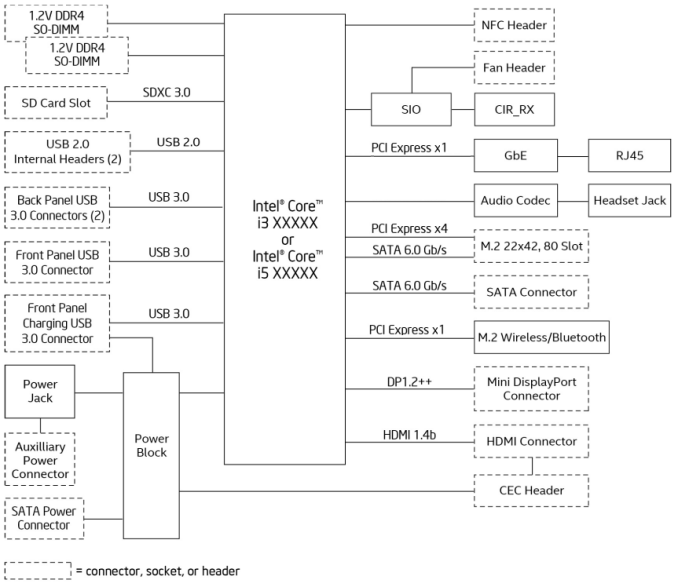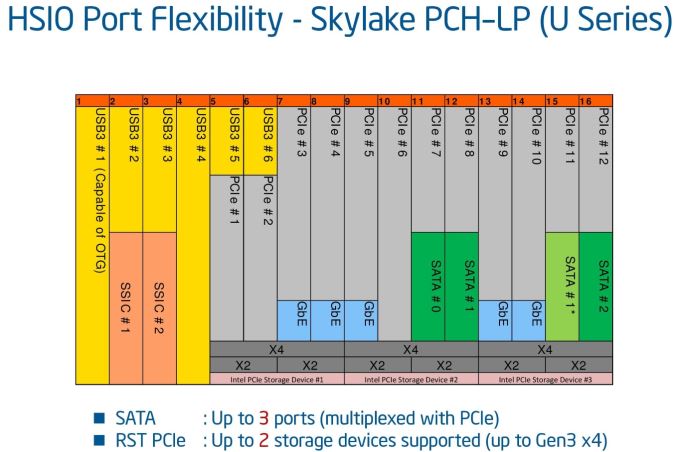Choosing the Right SSD for a Skylake-U System
by Ganesh T S on May 9, 2016 8:00 AM EST
Our Skylake NUC review had a brief section on the performance of the storage subsystem. The comments section raised a few questions about the inability of SSDs such as the Samsung SSD 950 PRO to achieve maximum performance in the NUC. After some discussion with Intel, we discovered some interesting aspects in the design of Skylake-U systems that have a bearing on the performance of some M.2 PCIe SSDs. These can affect the consumer's choice of SSDs for a Skylake-U system - be it a NUC or an user-upgradeable notebook.
Background
Intel has a wide range of CPUs based on the Skylake microarchitecture. These target a variety of markets ranging from tablets / 2-in-1s and Compute Sticks to the traditional tower desktops. The same microarchitecture is able to serve different markets because of the scalable nature of the TDP / power envelop (from 4.5W to 91W).
While the high-performance H-, S- and K- CPUs need a separate Intel 100 Series platform controller hub (Sunrise Point PCH), the Skylake-U and Skylake-Y are Multi-Chip Packages (MCP) that have the Sunrise Point-LP PCH die integrated with the CPU in a single package.
The communication between the CPU and the PCH in the H-,S- and K- systems is via the Direct Media Interface (DMI 3.0),a proprietary link protocol developed by Intel. Skylake-U/-Y series processors, on the other hand, have an On Package DMI interconnect interface termed as OPI. Unlike DMI 3.0, the OPI in Skylake-U/-Y can be configured to meet the desired power or performance needs of a mobile system design. The following table summarizes the differences between DMI and the two configurable OPI options in Skylake systems.
| Skylake CPU - PCH(-LP) Communication Link Characteristics | |||
| Aspect | DMI 3.0 | OPI GT2 | OPI GT4 |
| Applicable Systems | Skylake-H/-S/-K | Skylake-U/-Y | |
| Link Width | x4 | x8 | |
| Transfer Rate per Lane | 8 GT/s | 2 GT/s | 4 GT/s |
| Max. Theoretical Bandwidth | 3.94 GBps | 2 GBps | 4 GBps |
For all practical purposes, DMI 3.0 and PCIe 3.0 are equivalent, and this is important when a PCIe 3.0 x4 SSD is connected to the a Skylake-H/-S/-K system using PCIe lanes from the PCH. Any other peripheral communicating with the CPU at the same time as the PCIe SSD would end up creating a bottleneck at the CPU-PCH link. On the other hand, Skylake-U/-Y systems that have a PCIe 3.0 x4 SSD connected to the Sunrise Point-LP PCIe lanes will be directly impacted by the configuration of the OPI. The GT4 configuration should have enough bandwidth to get full performance from a PCIe 3.0 x4 SSD, but a GT2 configuration could end up throttling such a device.
Analyzing the Skylake NUC6i5SYK Storage Subsystem
In order to determine whether the Sylake NUC6i5SYK is affected by the OPI capabilities, it is essential to understand the board design and the way each of the peripheral ports connect to the CPU.
The above block diagram should be considered in conjunction with the Skylake PCH-LP high-speed I/O (HSIO) configuration options depicted below. One of the x4 links multiplexed with a SATA lane is used for the M.2 22x42,80 SSD slot. One of the PCIe lanes that gets multiplexed with GbE is connected to the Intel I-219V Ethernet Adapter., and yet another PCIe lane is used for the WLAN adapter. The important aspect to note here is that any M.2 SSD can have full PCIe 3.0 x4 connectivity to the Sunrise Point-LP PCH.
Intel's current technical documentation (PDF) for the Skylake NUC board mentions that the maximum possible performance for any M.2 SSD is around 1600 MBps. The Samsung SSD 950 PRO and SM951 PCIe 3.0 x4 NVMe SSDs claim performance numbers in excess of 2000 MBps. This obviously means that there is a bottleneck between the Skylake CPU and the Sunrise Point-LP.
Intel's Skylake-U/-Y reference designs are optimized for lower power and default the OPI to GT2 rates. In the development of the NUC6i5SY product family, the Intel team utilized the reference designs and default settings for the OPI and GT2 rates. Therefore, PCIe 3.0 x4 SSDs connected to the M.2 port of the NUC6i5SYK (BIOS v0042) are effectively limited to PCIe 2.0 x4 rates. This throttling makes sense for battery-operated devices like 2-in-1s, but, not so much for UCFF desktops like the NUCs.
After we brought this to Intel's attention, the development team decided to complete the necessary changes and validation to support the maximum PCIe 3.0 performance. Intel sent over a development BIOS (v1142) that turned on the higher performance OPI GT4 rate. This BIOS is scheduled to be made public before the end of May 2016 (after completion of internal validation).
Evaluating the NUC6i5SYK Storage Subsystem
The rest of this review deals with two major aspects - a quantitative measurement of the effectiveness of different types of SSDs in the Skylake NUC, and an evaluation of the improvements resulting from ramping up the OPI to GT4 rates (i.e, a comparison of the performance using BIOS v0042 and BIOS v1142). In order to do this, we processed various benchmarks while keeping everything other than the M.2 SSD and the BIOS version constant.
| Intel NUC6i5SYK Benchmarked Configuration | |
| Processor | Intel Core i5-6260U Skylake, 2C/4T, 1.8 GHz (Turbo to 2.9 GHz), 14nm, 4MB L2, 15W TDP |
| Memory | Corsair CMSX16GX4M2A2400C16 DDR4 15-15-15-35 @ 2133 MHz 2x8 GB |
| Graphics | Intel Iris Graphics 540 (Skylake-U GT3e) |
| Disk Drive(s) | Various M.2 SSDs |
| Operating System | Windows 10 Pro x64 |
| Full Specifications | Intel NUC6i5SYK Specifications |
The various benchmarks presented in the next few sections were all processed with the M.2 SSD as the primary drive. The drive was initialized with two partitions. The primary OS partition was set to be 120GB in size, while the remaining space was allocated to the secondary partition. Both of the partitions were formatted in NTFS with default settings.
In the next section, we will first take a look at the specifications of the four M.2 SSDs that were evaluated in the NUC6i5SYK, along with CrystalDiskMark scores for each in both the BIOS versions. Following this, we move on to real-world benchmarks - SYSmark 2014, PCMark 8 Storage Bench and a slightly tweaked AnandTech DAS Suite. Prior to our concluding remarks, we take a look at a few miscellaneous aspects - power consumption, thermal characteristics and pricing.













40 Comments
View All Comments
BPB - Monday, May 9, 2016 - link
"We also managed to check out four different SSDs for usage in Skylake-U systems in general (and the NUC6i5SYK in particular)."The new NUCs are not capable of using the 950 Pro at full speed. Yes, the specs look like they do, but they don't. The maximum speed supported is 1600MB/s. Page 45 of this doc has the specs:
http://www.intel.com/content/dam/support/us/en/doc...
You can also view a discussion at the Intel Community regarding this:
https://communities.intel.com/message/372201#37220...
This being the case, which SSD makes the best buy?
ganeshts - Monday, May 9, 2016 - link
Please go through the article at least once before commenting. Did you look at the CrystalDiskMark benchmark numbers with the NEW DEVELOPMENT BIOS? Intel has resolved this issue, and the whole point of this review was going into the reasons behind this.BPB - Monday, May 9, 2016 - link
Sorry, read while at work and only had time to breeze through. I looked for those numbers but didn't see them. Wish I could delete my post...willis936 - Monday, May 9, 2016 - link
Does this apply to all -U processors? I think far more interesting than NUCs are people with broadwell and skylake -U laptops.ganeshts - Monday, May 9, 2016 - link
This is applicable to all Skylake-U processors.Yes, notebooks are an interesting category that we have tried to cover in this article, but, without numbers to back up. Our impression is that the lower idle power needed for notebooks might make vendors go with the GT2 OPI setting. So, the numbers are likely to be closer to the BIOS v0042 results that we saw in this review. So, yes, it is likely that PCIe 3.0 x4 SSDs can't get full performance with Skylake-U laptops. Of course, vendors have the knob to turn on the higher performance / higher idle power setting, if they want.
rish95 - Tuesday, May 10, 2016 - link
You guys wouldn't happen to have power consumption numbers on the PM951, would you?It appears the Surface Book's drive is replaceable following a tedious opening procedure, and I've been thinking of replacing the 128 GB PM951 that came with mine with a larger 950 Pro or its successor. The 128 PM drive has terrible slow write performance due to the lack of TurboWrite.
However, I am concerned that the extra performance the 950 and SM series SSDs offer comes at a huge power penalty, and I certainly wouldn't want to give up the fantastic battery life this device offers.
ez76 - Monday, May 9, 2016 - link
How can I tell if my Skylake-U system has an OPT GT2 or OPT GT4 configuration?ganeshts - Monday, May 9, 2016 - link
Easiest way is to ask the manufacturer. Otherwise, if the system has a M.2 PCIe x4 slot for a SSD, benchmark something like the SSD 950 PRO using CrystalDiskMark.Hopefully, after Intel makes this BIOS public, more vendors will put out BIOS updates and spell the OPI link rate out in the change log.
Junkmail1 - Monday, May 9, 2016 - link
I went through the article twice and the comments once. Now I'm second guessing that choice!buyme50 - Saturday, May 14, 2016 - link
"However, the warranty aspect is a bit worrisome, since the SM951 is an OEM model."Thank you for mentioning this. I had an SM951 die recently. Newegg's third party seller would not honor the warranty posted (3 years), Newegg would not do anything, and Samsung refused to warranty it. Don't buy the SM951 unless you don't want a warranty and want to risk losing your data.